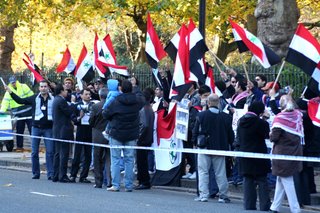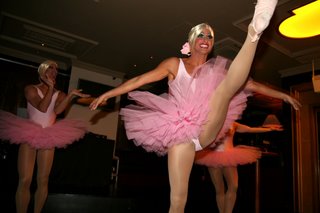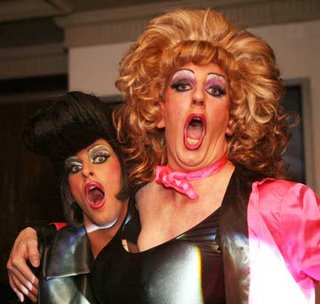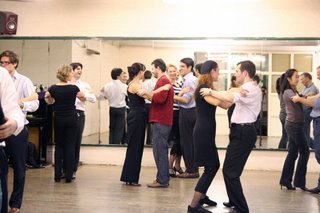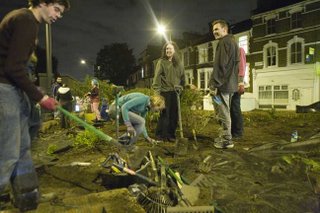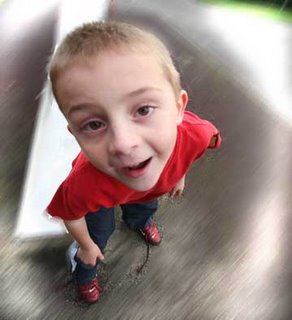pressmen performance and photography
Thursday, November 30, 2006
The Pressmen focus
Whenever we are working it is essential that we are totally in the moment. It is the same focus that I developed from performing on the stage or in streetshows. To be absolutely focussed yet aware of all that is going on around you. Capturing decisive moments with a camera requires this level of concentration. It could almost be called action meditation.
Wikkipedia on Cartier-Bresson
From Wikkipedia"Cartier-Bresson achieved international recognition for his coverage of Gandhi's funeral in India in 1948 and the last (1949) stage of the Chinese Civil War. He covered the last six months of the Kuomintang administration and the first six months of the Maoist People's Republic. He also photographed the last surviving Imperial eunuchs in Beijing, as the city was falling to the communists. From China, he went on to Dutch East Indies (now Indonesia), where he documented the gaining of independence from the Dutch.
In 1952, Cartier-Bresson published his book Images à la sauvette, whose English edition was titled The Decisive Moment. It included a portfolio of 126 of his photos from the East and the West. The book's cover was drawn by Henri Matisse. For his 4,500-word philosophical preface, Cartier-Bresson took his keynote text from the 17th-century Cardinal de Retz: "Il n'y a rien dans ce monde qui n'ait un moment decisif" ("There is nothing in this world that does not have a decisive moment"). Cartier-Bresson applied this to his photographic style. He said: "To me, photography is the simultaneous recognition, in a fraction of a second, of the significance of an event as well as of a precise organization of forms that give that event its proper expression."[citation needed]
Both titles came from publishers. Tériade, the Greek-born French publisher whom Cartier-Bresson idolized, gave the book its French title, Images à la Sauvette, which can loosely be translated as "images on the run" or "stolen images." Dick Simon of Simon & Schuster came up with the English title The Decisive Moment. Margot Shore, Magnum's Paris bureau chief, did the English translation of Cartier-Bresson's French preface.
"Photography is not like painting," Cartier-Bresson told the Washington Post in 1957. "There is a creative fraction of a second when you are taking a picture. Your eye must see a composition or an expression that life itself offers you, and you must know with intuition when to click the camera. That is the moment the photographer is creative," he said. "Oop! The Moment! Once you miss it, it is gone forever."[citation needed]
Cartier-Bresson held his first exhibition in France at the Pavillon de Marsan in the Louvre in 1955.
Tuesday, November 28, 2006
3 standards of Comic Paparazzi
There are various names for comic paparazzi. Fake,Digital,and spoof Paparazzi. They dress up and pretend to be real Paparazzi when guests arrive at an event.
There are 3 types of group. 1. the emphasis is on the interaction with the guests to create a fun atmosphere
2. The emphasis is on the photography and the theatrical capabilities are minimal
3. both the comic and the photographic
As a group we at the pressmen work on delivering a character based entertainment but one that is built on a professional understanding of how these theatrical techniques provide the means to capture candid and natural photographs. Our photo essays capture the essence and character of an event.
I wanted to say something clever. nothing comes to mind other than I enjoy doing this job.
paparazzi at corporate party
Chas and i worked at a function in the city yesterday. They had a 1950's theme and many of the guests dressed for the occassion. It was very dramatic in the venue as it had an old victorian theme, lots of shade, dramatic reds with the feel you might have with gaslight.
I did a lot of the talking, in the end I just put my camera down for a while. Because the guests were mostly young pub managers we could be really cheeky demanding that they posed for us. Ended up with a really jokey atmosphere. Chas took some really fantastic shots with a natural feel to them.
And yes later I was buzzing here and there watching and taking character shots. It still amazes me how I get caught up in the process of reading the reactions and character of the guests.
lightening strikes in wood green
I haven't posted for a few days. Saturday during a thunderstorm there was a bang and my router stopped working,a digital set top box died and the TV's color balance altered. My neighbours modem went kaput and another neighbour ended up with no phone. Almost expected Dr Who plus phone box to turn up in my living room.
Saturday, November 25, 2006
Friday, November 24, 2006
The pressmen, storytelling and events.
Storytelling and the paparazzi. Previously I have talked about the photobooks we can create and how they are a photo essay of an event. However that begs many questions as to how you actually do this in practice. There is the Bresson idea of the decisive moment. There is the accepted norm by many 'portraitists' of the importance to create a sense of warmth and relaxation in the sitter.
In an event the work has to happen in the moment. To instantly get people to relax and to look for those decisive moments that reveal something of the guests personality. We at the pressmen have developed the art of Rapportage, to get a candid shot at the same time as creating instant rapport. We have learned much from theatrical techniques based on character,movement,focus,inner stillness,being able to be part of a moment yet still to have a directorial eye from the outside. Superficially the costume of the 1950's paparazzi enable both us and the participants to join in a storyline. But it is a moment that has a sense of play. The very moment of rapport. This deepens over the evening as people get used to us and enter into both verbal and non verbal interaction. This provides a catylyst to openess on the part of guests because they have acceptes the pressmen as part of their world.
All this time the pressmen must remain totally in the moment and be constantly reading what is going on and being open to seeing guests reactions. during the evening we start to get a sense of the character and spirit of individual guests and this helps in seeing the possibility of interesting photographs. Throughout this process just like a theatre director or a writer we must be aware of the story that is developing. We are photographing that as well as the individuals.
All of which allows one to creatively explore that story as one chooses the pictures for inclusion in the book and the ways they are layed out.
I think that is what makes this form of storytelling exciting and fulfilling.
Storytelling and business
I have recently read 2 books, Seth Godin, 'All Marketers are liars' and T.L.Gargiulo, 'Stories at work,using stories to improve communication and build relationships.'
I was disappointed by both books. however I did find ideas which interested me. Godin is very clear how important stories are to marketing plans. How do you create a story about your business? Earlier I have referenced the Wikkipedia definition of storytelling.
Your website tells a story both consciously and unconsciously. you write words to convey ideas that you think will convey what you think will be important for your expected reader. Underlying that are the signals from the design,the color,the visual images,the look. You have to understand what story you want to put over and understand how that can be conveyed.
wikkipedia on storytelling
Wikkipedia,"Storytelling is the ancient art of conveying real or fictitious events in words, images, and sounds. Stories have been shared in every culture and in every land as a means of entertainment, education, preservation of culture and to instill knowledge and values morals. Storytelling is often considered to be a crucial aspect of humanity. Human beings have a natural ability to use verbal communication to teach, explain, and entertain, which is why storytelling is so prevalent in everyday life. Traditional storytelling differs from multi-media storytelling, in that it is experienced, and forms within the mind of the audience. For example, a described dragon will be different for each audience member, while a visual representation will be more specific. Since traditional storytelling relies on the recipient's personal experience and imagination, it tends to be stronger in impact.
The earliest forms of storytelling were oral, combined with gesture and expression: words were spoken from one person to another in an effort to communicate a message or a feeling. Stories are also seen in the artwork scratched onto the walls of caves. With the invention of writing, stories were recorded, transcribed and shared over wide regions of the world, such that today, the medium most commonly-associated with storytelling is the novel. As human activities have become more refined and complex, visual stories have been presented in images carved into wood or bamboo, ivory or stone, painted on either canvas or paper, recorded on film and stored electronically as digital images.
Traditionally, oral stories were passed from generation to generation, and survived solely by memory. With written media, this has become less important. Conversely, in modern times, the vast entertainment industry is built upon a foundation of sophisticated multimedia storytelling.
Robert Begiebing et al (2004) summarize personal and professional experiences making successful modern films, novels, biographies, articles, museum displays, and poems. Even in these forms, storytellers try to create a sense of engagement or dialog with the audience. As a professor of English, Begiebing hypothesizes that the effective writer provides just enough clues to get the reader's imagination, intellect, and emotional responses involved in figuring out what is going on in the story. The stories that last through the ages "leave plenty up to the reader."
magnetic marketing questions
Cliff Allen,"The key to creating a magnetic site that performs well over the long term is to help people become more efficient at activities they need or desire to participate in, which makes you more valuable to your target audience."
Easier said than done. Could be a great resource but what makes people see it in the first place. Same old marketing problem.
Wednesday, November 22, 2006
Olympics in london- more confusion
BBC reports,"Ken Livingstone has denied the 2012 Olympics finances are in chaos - as he contradicted what Culture Secretary Tessa Jowell told MPs on Tuesday.
Ms Jowell said the cost of the Olympic Park had risen from £2.4bn to £3.3bn, blaming inflation and the decision to spend £400m on a "delivery partner".
But London's Mayor insisted the £2.4bn figure stood, saying any increase was due to other regeneration work.
"Nothing is a mess, everything is going exactly according to plan," he said.
For the Lib Dems, Don Foster MP said the differing messages underlined the need for greater scrutiny of costs in Parliament.
"Ken Livingstone's bizarre denial of cost overruns has merely added to the confusion," he said."
Hello, whats true here. Accounting figures should be clear. Accountability- I don't think so.
So as a londoner I didn't get to vote on whether I wanted to be involved in paying for these games. And now who knows how much as the politicians and administrators can't agree on what the figures are and which ones count.
Do the words farce ring any bells?
Tuesday, November 21, 2006
Londoners face new taxes
BBC"The expected cost of the 2012 London Olympic park has risen 40% since the games were won in July 2005, Culture Secretary Tessa Jowell has told MPs.
The extra £900m cost was likely to be met by London council tax payers and lottery funds, Ms Jowell suggested."
So Londoners will have to pay more money. Did we vote for this to happen,I don't think so. And the congestion charge went up,did we vote for this to happen,I don't think so. The congestion zone is getting larger. Did we vote for this to happen,I don't think so.
Do the words Ken Livingstone and democracy go together? Ask yourself that one.
Monday, November 20, 2006
The nightmare in the Congo
http://www.msnbc.msn.com/id/15704030/site/newsweek/
Again another story of atrocities that don't really form part of public discourse. Another silence. Another non trendy,non newsworthy part of the world.
Sunday, November 19, 2006
Tradegy in Darfur
Headheeb.blogmosis.com wrote,"No more relief
One lesson learned through bitter experience in the Darfur-Chad-CAR conflict is never to assume that things have hit bottom. And if the Norwegian Refugee Council's pullout from the region proves to be a bellwether for other relief agencies, the humanitarian situation may be about to get worse in a major way:
he international humanitarian organisation Norwegian Refugee Council has closed down its relief operations in Darfur, western Sudanese, a move it said will affect 300,000 internally displaced persons (IDPs) in the troubled region.
"We have been suspended by the government for the last two months for no clear reason," Astrid Sehl, NRC media and communications officer said on Friday. "We have tried to get into dialogue with the authorities to discuss whether we can come back, but they do not seem interested."
The IDPs who have been receiving protection and humanitarian aid from the NRC include some 93,000 in Kalma, of whom 19,000 are children enrolled in an education programme and 128,000 in Gereida. Both camps are in South Darfur State. Others are 10,000 in Otash and 52,000 who have been receiving food aid in Nyala, the capital of South Darfur State. Otash camp has recently seen the arrival of more IDPs as a result of continuing violence.
The NRC said working conditions in Darfur had become impossible. "The frequent disruption of our humanitarian work, such as suspension for a sum total of 210 days, is forcing us to take this very difficult decision," Tomas C. Archer, the Secretary-General, who recently met authorities in South Darfur and Khartoum, said in a statement.
One can always hope for the best, but I very much doubt that the NRC will be the last organization to quit Darfur. In the past few months, many other relief agencies have cut back their operations in the area due to the deteriorating security situation, and the danger is only increasing as the fighting heats up. If enough agencies pull out, then hundreds of thousands of IDPs will have to choose between a long, uncertain desert journey to more "stable" regions such as Niger or Cameroon, and the even more uncertain prospect of remaining in a war-torn region without food or security. The United Nations isn't even close to prepared for a refugee flow of this size, and the potential humanitarian catastrophe could exceed what has gone before. This is not a drill, and there's very little time left to wait on Khartoum to permit a stabilizing presence."
The blog at Head Heeb is a very good source for information on various conflicts around the world.
suprise, darfur again
BBC,"The Sudanese government together with the Janjaweed militia have launched new attacks in northern Darfur, the African Union (AU) has said."
All the talk of an agreement between the sudanese government and the UN a few days ago and now this.
Friday, November 17, 2006
re 28mm
It is interesting the focus of this artist. As a series of photographs he is doing interesting work, but as to whether there is a lot more to his work on a deeper level- maybe,maybe not.
Thursday, November 16, 2006
28millimetre.com real street photography
"The photographer-activist, JR, converts his pictures into posters and transforms our streets into universal open-air galleries. From Los Angeles to Berlin, he keeps his independence and illegal exhibits in the streets, which he considers to be his very own gallery.
After his first guerrilla exhibition on the walls of Montfermeil's ghetto's (93/370) in 2004, JR settled down right in the heart of the district collaborating with Ladj Ly, inhabitant of the ghetto, actor and director from the collective, Kourtrajmé.
Armed with a 28 mm lens, JR shot full frame portraits of young people from this neighbourhood and the nearby district of
The Forestière (Clichy-sous-Bois, 93). This no frills, straightforward
technique allowed them to get very close to this generation.
Interviewing them, without restrictions, on the recent events of
November 2005. The first portraits were illegally pasted on the east
walls of Paris, a district that was once run-down, but has now become a residency for the bourgeois bohemian, who are shielded from the flames.
With a certain « in your face » rudeness, they provoke passers-by and question the social and media representation of a generation that people only want to see outside the doors of Paris or on the news. The Book 28mm - portrait of a generation, is a collection of the 28 most meaningful portraits from the whole series.
Also included are some on the spot shots of moments shared with the young people of The Forestière, as well as several actions shots from the streets in 2005. "
" Emile Abinal "
Tuesday, November 14, 2006
darfur Again
The BBC report 'Darfur militias in deadly attacks'
Still not headline news. Still whats seems to be an ominous silence in the public sphere.
Monday, November 13, 2006
Bob burg on networking for business
'Networking is the cultivating of mutually beneficial give-and-take, win-win relationships."
"All things being equal people will do business with, and refer business to, those people they know, like, and trust."
Communication over time requires trust. In a transaction when a promises b something b expects that a will do what he says in a way that both parties have agreed to. In that way over time a base of trust is created. Talk the talk and walk the walk.
All the way along the line both parties rely on truthfulness. integrity is also an important part of this equation.
It strikes me that for BNI to work as a networking organisation the members need to adhere to these sort of standards. Without honesty and integrity from all members the cultivating of positive relations cannot grow.
I do recommend for all those interested in developing their networking skills to look at 'Endless Referrals' by Bob Burg.
Sunday, November 12, 2006
Imelda Marcos still in the news
The BBC reports
"The woman reputed to have once owned 3,000 pairs of shoes has launched her own fashion label. Imelda Marcos, wife of the deposed ruler of the Philippines, has kicked off her collection with a range of jewellery."
Interesting that whatever you do it is still possible to remain in the news and to remain as a celebrity. The focus of the media helps shape this phenomena and that in its turn is shaped by the editor and their teams thinking on what will sell.
But they help create what will sell by their choices.
I have just read a book about Paparazzi who only exist because newspapers etc are willing to pay vast sums for their pictures.
All of this opens questions as to the sanity of our culture. But then what is sane and what is madness.
Michel Foucault wrote an interesting book on madness and civilisation. He looks at the development of the concept of madness, how it first came into being in the modern world. He links that to ideas of the development of power in our society.
I think all of this is very difficult to understand. I still feel very uncomfortable at the way some people still remain in the public eye continuing to make large amounts of money yet they have done things that are are morally unjustifiable.
Saturday, November 11, 2006
mind mapping for business
A long time ago I was taught the basic idea of mind mapping and I have used it to help me shape ideas. In many facets of your business you will have a range of possible actions to take. Using mind mapping techniques it is possible to analyse visually the ideas. in this way it is easier to develop conclusions and take action.
I would recommend a book called the mind map book by tony and barry buzan. It is a BBC publication.
Friday, November 10, 2006
fame and photography
November/December 2006 David Schonauer
"The baffling calculus of fame is hard enough to get your head around, even without factoring in the strange metaphysics of photography.
Andy Warhol’s theorem that everyone would have it for 15 minutes certainly factored in the power of images to transfix the culture’s attention, as well as the growth curve of the mass media and its resulting tendency to shorten our collective attention span. The broad implication of this insight was that modern culture would treat the untalented and unworthy with unquestioning fascination. On the other hand, Warhol knew that everyone -- even the truly talented -- would be disposable, because the search for the next big thing was always on."
wikipedia on candid photography
"The photographic setup of candid photography is best described as un-posed and unplanned, immediate and unobtrusive. This is in contrast to classic photography, which includes aspects such as carefully staged portrait photography, landscape photography or object photography. Candid photography is supposed to catch rare instances of life from the very immersion into it, rather than to produce imagery of still life, to catch rare moments of "reality" which presupposes a definition of "reality."
Candid photography is also set off against the voyeuristic stalking involved in animal photography, sports photography or photographic journalistic intrusion, which all have a very strong technical focus on getting distant objects photographed, e.g. by using telephoto lenses. Candid photography's setup includes a photographer who is typically there with the "subjects" to be photographed if not close, and not hidden. People photographed on candid shots either ignore or accept the close presence of the photographer's camera without posing for photos.
The events documented are often private, they involve people in close relation to something they do, or they involve people's relation to each other. Candids are the kinds of pictures taken at children's birthday parties and on Christmas morning, opening the presents; the pictures a wedding photographer takes at the reception, of people dancing, eating, and socializing with other guests. They are taken at leisure, or at special occasions, they show people as they are when they do not prepare to be photographed."
For event photography the pressmen are after the un-posed,unplanned and immediate photographs. Spontaneous but not necessarily unobtrusive. Theoretically this involves certain problems regarding an understanding of 'reality' however in practice one tries to capture a story which one is an observer of as well as a particpant.
Wikipedia on photojournalism
"Photojournalism is a particular form of journalism (the collecting, editing, and presenting of news material for publication or broadcast) that creates images in order to tell a news story. It is now usually understood to refer only to still images, and in some cases to video used in broadcast journalism. Photojournalism is distinguished from other close branches of photography (such as documentary photography, street photography or celebrity photography) by the qualities of:
Timeliness — the images have meaning in the context of a published chronological record of events.
Objectivity — the situation implied by the images is a fair and accurate representation of the events they depict.
Narrative — the images combine with other news elements, to inform and give insight to the viewer or reader.
Photojournalists must make decisions instantly and carry photographic equipment under the same circumstances as those involved in the subject (fire, war, rioting)—often while being exposed to the same risks.
Photojournalism as a descriptive term often implies the use of a certain bluntness of style or approach to image-making. The photojournalist approach to candid photography is becoming popular as a unique style of commercial photography. For example, many weddings today are shot in photojournalism style resulting in candid images that chronicle the events of the wedding day."
Wikipedia on reportage
"Reportage is also a term for an eye-witness genre of journalism: an individual journalist's report of news, especially when witnessed firsthand, distributed through the media. This style of reporting is often characterized by travel and careful observation."
I like the phrase careful observation. In event photography it is so important to concentrate and observe all that is happenning around one in order to catch those interesting moments that stand out from the rest.
Thursday, November 09, 2006
More on reportage and weddings
Reportage is different from traditional wedding photography, which is for the most part concerned with controlled or staged portraits. Reportage is more concerned with capturing the story of an event as per a photo essay. Trying to capture the spirit and character of the guests. The traditional way to achieve this was to stay in the backgroung photographing candid shots as you see events unfolding. It is true there are reaction shots which are natural. It is also possible to interact with guests to create shots and still their reactions are natural and show their true emotions at that moment.
History of photo-reportage
A quote from Photolondon,
"The early 1930s saw the emergence in Britain of a new kind of photography, which its practitioners called 'photo-reportage'. These photographers were mostly well-educated émigrés from Germany who left after Adolf Hitler was elected Chancellor in 1933. They brought with them the experience of producing photographic stories for popular German illustrated magazines which they had themselves researched, photographed and written. Britain's first magazine based on this continental model was Weekly Illustrated which was established in London in 1934 under the editorship of Stefan Lorant, a Hungarian who had edited illustrated magazines in Germany before being arrested and deported by the Nazis in 1933."
Tuesday, November 07, 2006
networking and ecademy
I recently discovered an online networking group called ecademy which I think was founded by the guys who wrote a book the beermat entrepreneur. They have a free part to their site which allows one to go to a free networking evening.
The event was last night and was held in a bar near canon street. I found everyone friendly and probably managed to speak to about one third of the participants. The event I do not believe will create immediate contacts as a rule. However I do think it provides a means to build up ones networks which will in the long run lead to more business for all.
For a small business this is a useful and direct way to create a part of ones marketing mix. Strange using the word mix as it makes me think of the cinema and the pick and mix sweet section.
As you can see I think this is a good idea. With one proviso any networking event requires that you know a little about how to behave in this type of environment. With this in mind I would recommend a book called endless referrals and is written by Bob Burg.
